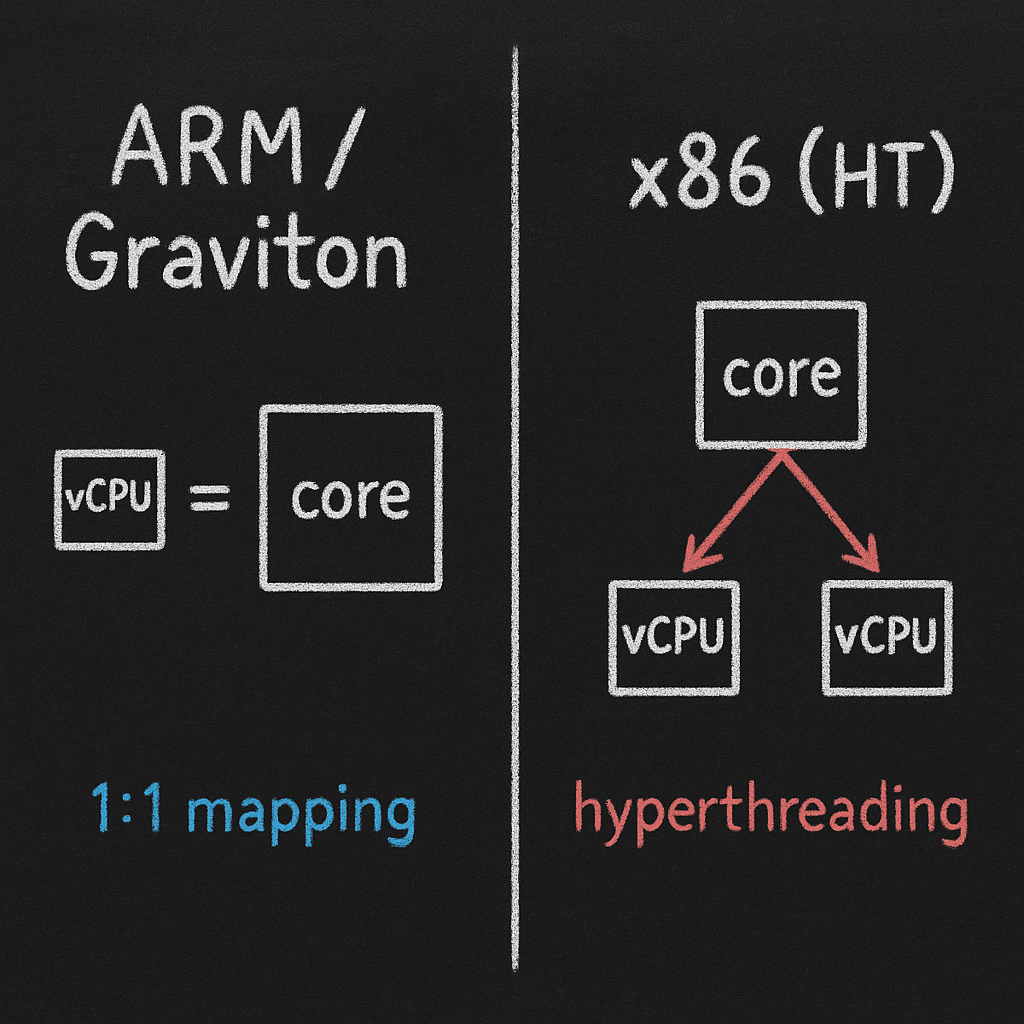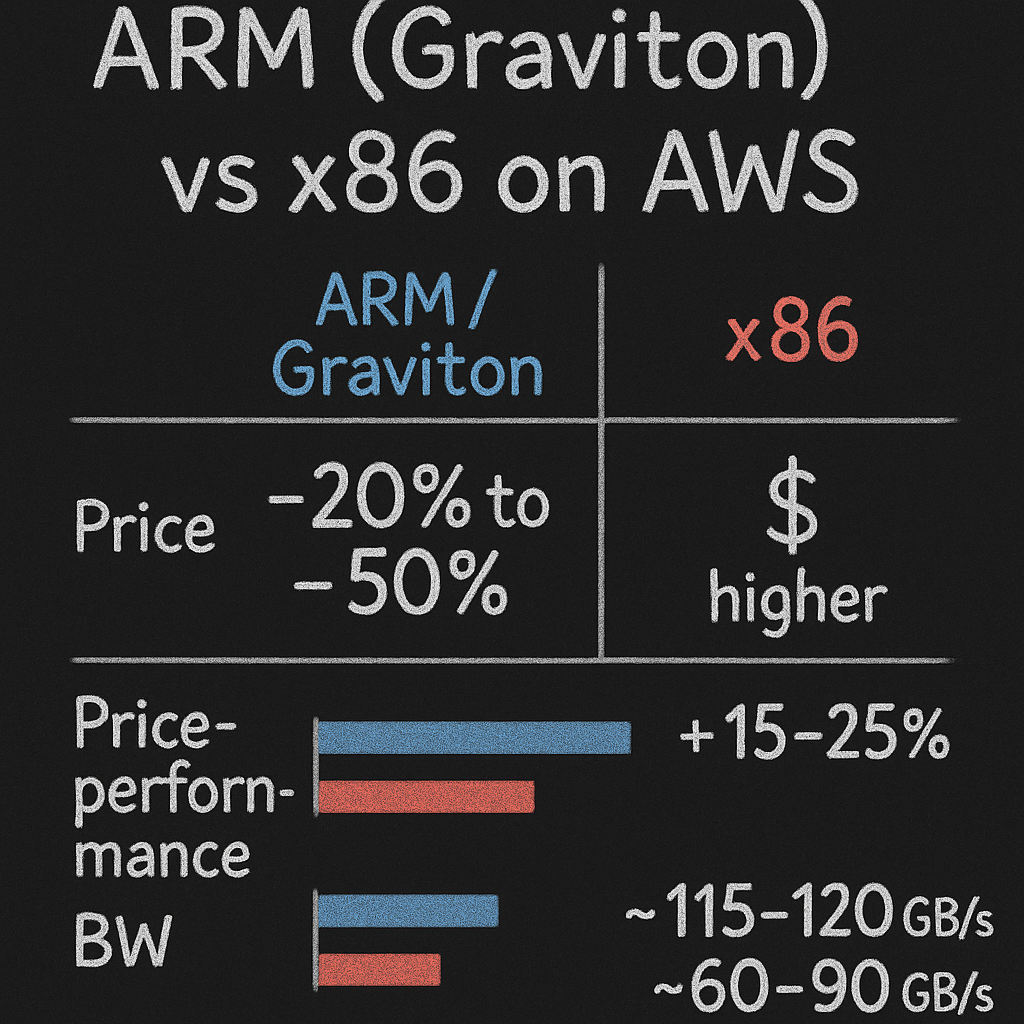ARM vs x86 pricing on AWS: a practical guide to choosing between architectures
Is your AWS bill giving you sticker shock? You’re not alone. One increasingly popular cost-optimization strategy is migrating workloads from traditional x86 architecture to AWS ARM-based Graviton processors. But is it always the right choice for your specific workloads?
The architectural fundamentals: ARM vs x86 on AWS
AWS Graviton processors use ARM64 architecture and are custom-built by AWS specifically for cloud workloads. This contrasts with Intel and AMD x86 processors that power traditional EC2 instances.
A key architectural difference: Graviton maps one vCPU to one physical core, while x86 instances use hyperthreading to present multiple virtual cores per physical core. This difference significantly impacts performance profiles and cost efficiency.

Cost comparison: how much can you actually save?
The price advantage of Graviton is substantial and well-documented across multiple use cases. Graviton instances cost approximately 18–20% less per hour than comparable Intel Xeon instances, with organizations typically achieving 20-40% cost reductions when migrating compatible workloads.
When combined with right-sizing, Savings Plans, and other optimization techniques, total savings can reach 50-55%. GOV.UK demonstrated this by achieving 15% per-instance savings migrating from m6i (x86) to m7g (Graviton), with total savings reaching 55% when combined with right-sizing and Savings Plans.
A real-world example shows that a compute workload costing $91K annually on Graviton might cost $182K on Intel—a potential 50% reduction. Additionally, Graviton processors reduce power consumption by up to 40% compared to traditional x86 instances, allowing AWS to pass savings through reduced pricing.
Performance reality: when ARM outperforms x86
Contrary to some misconceptions, Graviton often delivers equal or better performance than x86 equivalents:
AWS Graviton processors provide 15-25% better price-performance for disk-bound and CPU-bound workloads. Graviton3 delivers up to 25% better price-performance compared to Graviton2 for compute-intensive tasks, while C7g instances demonstrate 25% better computational performance and 30% compute cost reduction compared to x86 C5 instances in real-time workloads.
Memory bandwidth is substantially higher: Intel Xeon 60-70 GB/s, AMD EPYC 80-90 GB/s, AWS Graviton3 115-120 GB/s.

For multi-threaded applications that can leverage Graviton’s one-to-one vCPU-to-core mapping, the performance advantage is especially pronounced. According to performance benchmarks for AWS Graviton processors, Graviton4 consistently outperforms both AMD EPYC Genoa and Intel Xeon Sapphire Rapids in HPC workloads.
SPEC CPU 2017 integer rate performance estimates show Intel Xeon Platinum 8375C at ~155, AMD EPYC 7R13 at ~170, and AWS Graviton3 at ~180, giving Graviton a clear performance edge.
Lambda on ARM vs x86: the serverless equation
For AWS Lambda functions, the cost-performance equation shifts in interesting ways:
Lambda functions powered by Graviton2 generally result in better performance and lower cost, leading to significantly better work per dollar. The pricing difference is approximately 20% lower for ARM-based Lambda functions.
However, memory-heavy Lambda workloads that are latency-sensitive may still perform better on x86-based instances. This highlights the importance of testing your specific Lambda functions on both architectures before committing to a migration.
When x86 still makes more sense
Despite Graviton’s advantages, x86 instances remain better for certain workloads:
For single-threaded workloads, x86 instances offer 6-14% better price-to-performance compared to Graviton instances. When CPU resources are fully utilized with spot instances, high-clocked Intel x86 instances can provide 20% and 8% better price performance compared to Graviton.
Additionally, Windows-dependent applications aren’t supported on Graviton, and legacy applications with x86-specific dependencies may not run properly. Applications requiring specific Intel instruction sets or proprietary software lacking ARM64 builds will also perform better on x86.
Organizations often maintain a hybrid approach, using Graviton for compatible workloads while keeping specific x86 instances where necessary.
Compatibility considerations before migration
Before migrating to Graviton, assess compatibility across your software stack. Graviton processors use ARM64 architecture, requiring software to be compiled for or compatible with this instruction set.
Major Linux distributions like Amazon Linux 2, Ubuntu, RHEL, and Debian fully support ARM64. Programming languages including Python, Java, Node.js, Go, and .NET Core on Linux support ARM64 natively. Most popular Docker images have ARM64 builds, but custom images require ARM64 builds.
For databases, Amazon RDS, Aurora, and self-managed PostgreSQL, MySQL, MongoDB, and Redis work well. Core AWS services work identically on Graviton with no configuration changes.
For a detailed compatibility checklist, refer to the compatibility of software with AWS Graviton guide.
Migration strategy: maximizing savings while minimizing risk
To successfully migrate to Graviton:
Start with low-risk workloads like stateless applications, development environments, and non-critical services. Use a phased approach with canary or blue-green deployments starting at 5-10% traffic.
Establish baseline metrics pre-migration and closely track post-migration performance. Match Graviton instance families (m7g, c7g, r7g) to workload characteristics for general purpose, compute-optimized, and memory-optimized workloads respectively.
For maximum savings, combine Graviton with other cost-saving measures like Spot Instances, Auto Scaling, and EBS optimization. An e-commerce platform example shows that switching 20-100 instances in an auto-scaling group to Graviton could save $800-1,200 per day during peak events.
Many organizations complete their migration in 9-12 weeks, with 1-2 weeks for assessment, 2 weeks for environment preparation, 4 weeks for application testing/optimization, and 4 weeks for gradual rollout and monitoring.
Real-world results: what organizations are achieving
The cost and performance benefits of Graviton are backed by impressive real-world results:
Domo and DoubleCloud reported 20% price-performance improvements after switching to Graviton-based instances. A test comparison between c7i.2xlarge (x86) versus r8g.xlarge (Graviton4) measured +9% performance improvement and 33% lower cost for the Graviton instance.
Workloads running on 10 x86-based instances typically require only 6–8 Graviton instances to deliver the same or better performance, representing significant infrastructure consolidation.
For Java applications specifically, Graviton4 is up to 45% faster for large Java applications than Graviton3, and Azul Platform Prime performs more than 30% better on Graviton4 than vanilla OpenJDK across a wide range of performance tests.
Automating the cost optimization process
While manual migration to Graviton can yield significant savings, automated tools can maximize these benefits through continuous optimization, multi-layer optimization strategies, and risk mitigation capabilities.
Hykell offers automated AWS cost optimization that can reduce cloud costs by up to 40% by analyzing EC2, EBS, and Kubernetes environments while maintaining application performance. Their approach includes real-time monitoring of cloud expenses and detailed cost audits to identify underutilized resources.
Next steps: assessing your ARM migration potential
To determine if Graviton is right for your workloads:
- Audit your AWS environment for ARM-compatible applications using AWS Compute Optimizer
- Identify priority migration candidates - containerized applications, Linux-based services, and compute-intensive workloads
- Test performance on Graviton using parallel test environments
- Calculate potential savings based on current x86 instance costs versus equivalent Graviton instances
- Develop a phased migration plan starting with non-critical workloads
For organizations serious about optimizing AWS costs, migrating applications to Graviton instances represents one of the most impactful strategies available today.
By making informed architecture choices based on workload characteristics rather than defaulting to x86, you can significantly reduce your AWS bill while potentially improving performance. The key is understanding which workloads benefit most from ARM architecture and developing a methodical migration approach that minimizes risk while maximizing returns.
